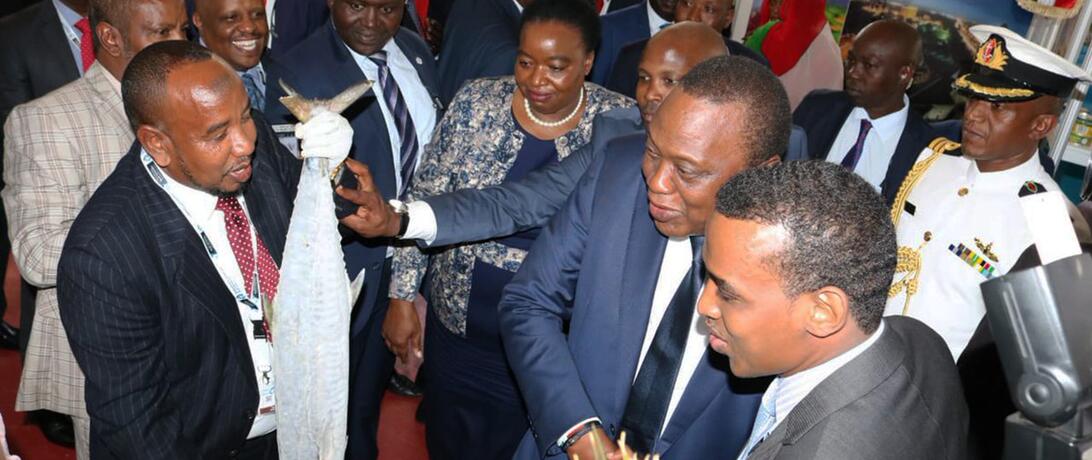
Reflecting on the inaugural Sustainable Blue Economy conference, Dr. Sarah Glaser discusses 3 reasons Somalia’s fisheries should make us optimistic for its blue economy.
This week, thousands of delegates—presidents and heads of state, scientists, diplomats, and representatives of industry and nonprofit sectors—gathered in Nairobi for a historic, inaugural Sustainable Blue Economy conference. The global gathering focused on how marine resources can promote sustainable development, social progress, and economic growth.
Kenya’s neighbor to the north, Somalia, made a strong showing at the conference. Anchored by the Somali Fisheries exhibition booth, proudly displaying a Somali Rising banner, the Somali delegation was led by President Mohamed Abdullahi Farmajo, the Ministry of Fisheries and Marine Resources, and the Ministry of Port and Maritime Affairs.
Kenya and Somalia have good reason to cooperate on blue economic issues. Many of their coastal resources are shared. Southern Somalia is home to a productive shrimp fishery, the beautiful Bajuni Islands that could one day support tourism, and endangered sea turtle nesting grounds. Cross-border cooperation would improve management of these resources: collaborative stock assessment and quotas for shrimp harvest are necessary to preserve the stock, the Kenyan tourism industry based in the Lamu Archipelago could serve as a model for southern Somalia, and joint campaigns to protect sea turtle nesting grounds would have greater impact.
President Farmajo spoke about the potential for blue economic growth in the waters around Somalia. In his words, “Somalia potentially stands to gain the most from a robust and sustainable blue economy.” The waters around Somalia are extremely productive and support diverse and valuable marine life: the monsoon winds help drive seasonal upwelling of nutrients and food. While the domestic fishing sector is small, international attention has recently turned toward supporting Somali fishing businesses. Their growth has the potential to support local livelihoods and the national economy, if developed responsibly. Fortunately, investors and policymakers alike appear to be committed to sustainable development.
Here are three reasons why Somalia’s fisheries should make us optimistic for its blue economy:
- Somalia’s fisheries are one of its most important blue economic resources.
But they’re far from untapped. In 2014, the value of fish catch in Somali waters by both foreign and domestic vessels was about $260 million. This ranks Somalia 17th out of 38 African nations reporting fish catch.
- They have room to grow—if they’re developed sustainably.
Our research shows Somali waters could support up to four times more fish catch than is currently harvested, but only for certain types of fishes. Top predators like sharks, tuna, and marlins are already fully exploited, but small pelagic fishes like the Indian oil sardine could be caught at much higher rates.
- Somalia has higher than average sustainability and resilience to climate change.*
According to One Earth Future’s Stable Seas Maritime Security Index, the Somali blue economy has two important strengths relative to other coastal African nations: higher than average sustainability and higher than average resilience to climate change. This means Somalia is well-positioned to invest in sustainable blue economic growth, unlike so many other countries that must first focus on undoing the damage caused by decades of overexploitation.
The blue economy is a critical part of the international community’s 2030 Agenda for Sustainable Development. In the case of Somalia, blue economic growth is also key to stability. According to President Farmajo, “We are fully aware of the inextricable link between peace and security, and sustainable development.” Food security from fisheries, long-term profits from tourism, and national revenue from mineral development would exemplify that sustainable blue economic growth can create resilient and prosperous coastal communities.
*This was accurate at the time of writing, but ND-GAIN data released in 2020 reveals that the Somali region has lower than average resilience to climate change.
Article Details
Published
Topic
Program
Content Type
Opinion & Insights